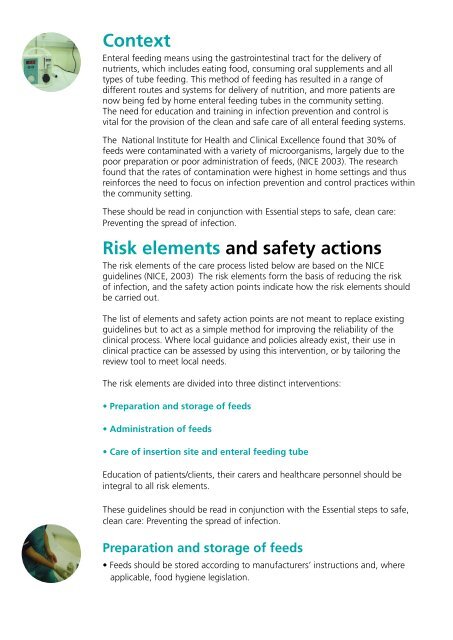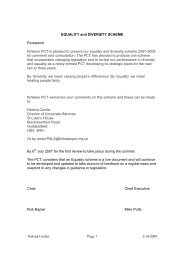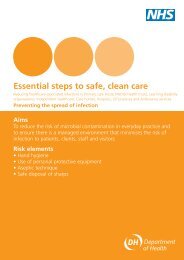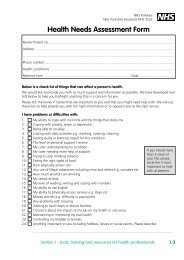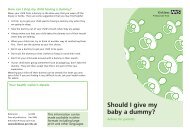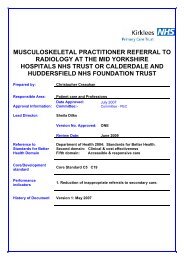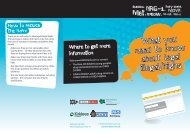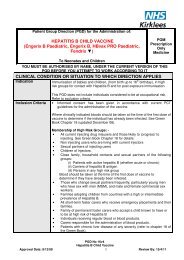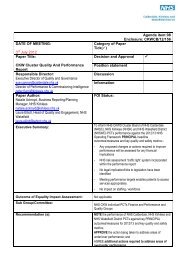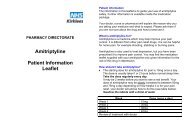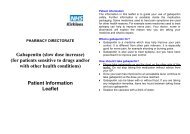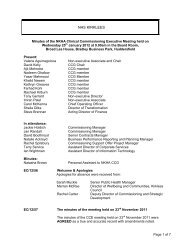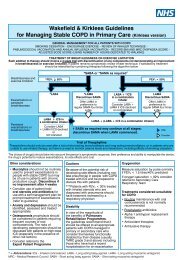Essential steps to safe, clean care - Enteral feeding - NHS Kirklees
Essential steps to safe, clean care - Enteral feeding - NHS Kirklees
Essential steps to safe, clean care - Enteral feeding - NHS Kirklees
Create successful ePaper yourself
Turn your PDF publications into a flip-book with our unique Google optimized e-Paper software.
Context<br />
<strong>Enteral</strong> <strong>feeding</strong> means using the gastrointestinal tract for the delivery of<br />
nutrients, which includes eating food, consuming oral supplements and all<br />
types of tube <strong>feeding</strong>. This method of <strong>feeding</strong> has resulted in a range of<br />
different routes and systems for delivery of nutrition, and more patients are<br />
now being fed by home enteral <strong>feeding</strong> tubes in the community setting.<br />
The need for education and training in infection prevention and control is<br />
vital for the provision of the <strong>clean</strong> and <strong>safe</strong> <strong>care</strong> of all enteral <strong>feeding</strong> systems.<br />
The National Institute for Health and Clinical Excellence found that 30% of<br />
feeds were contaminated with a variety of microorganisms, largely due <strong>to</strong> the<br />
poor preparation or poor administration of feeds, (NICE 2003). The research<br />
found that the rates of contamination were highest in home settings and thus<br />
reinforces the need <strong>to</strong> focus on infection prevention and control practices within<br />
the community setting.<br />
These should be read in conjunction with <strong>Essential</strong> <strong>steps</strong> <strong>to</strong> <strong>safe</strong>, <strong>clean</strong> <strong>care</strong>:<br />
Preventing the spread of infection.<br />
Risk elements and <strong>safe</strong>ty actions<br />
The risk elements of the <strong>care</strong> process listed below are based on the NICE<br />
guidelines (NICE, 2003) The risk elements form the basis of reducing the risk<br />
of infection, and the <strong>safe</strong>ty action points indicate how the risk elements should<br />
be carried out.<br />
The list of elements and <strong>safe</strong>ty action points are not meant <strong>to</strong> replace existing<br />
guidelines but <strong>to</strong> act as a simple method for improving the reliability of the<br />
clinical process. Where local guidance and policies already exist, their use in<br />
clinical practice can be assessed by using this intervention, or by tailoring the<br />
review <strong>to</strong>ol <strong>to</strong> meet local needs.<br />
The risk elements are divided in<strong>to</strong> three distinct interventions:<br />
• Preparation and s<strong>to</strong>rage of feeds<br />
• Administration of feeds<br />
• Care of insertion site and enteral <strong>feeding</strong> tube<br />
Education of patients/clients, their <strong>care</strong>rs and health<strong>care</strong> personnel should be<br />
integral <strong>to</strong> all risk elements.<br />
These guidelines should be read in conjunction with the <strong>Essential</strong> <strong>steps</strong> <strong>to</strong> <strong>safe</strong>,<br />
<strong>clean</strong> <strong>care</strong>: Preventing the spread of infection.<br />
Preparation and s<strong>to</strong>rage of feeds<br />
• Feeds should be s<strong>to</strong>red according <strong>to</strong> manufacturers’ instructions and, where<br />
applicable, food hygiene legislation.


